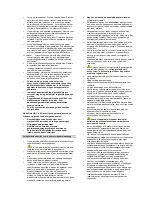
Start-up Assistance
•
CAUTION!
At the start up process can over voltages
arise, the on-board electronics could damage their
vehicle. Please discuss with your automotive specialist
•
battery and connect the vehicle to be clamped!
•
On principle, two persons should always start up a
vehicle with chargers.
•
The first person shall push the Start button on the
charger
The other one shall immediately start the
ignition.
•
As the vehicle starts up, stop starting immediately, max.
9-10 sec.
•
If the attempt to start fails, wait about 5 minutes for the
charger to get cooled and only then begin another
attempt to start.
Tip: If you change the battery for 10-15 minutes to
subpoena requires much less battery power startup.
Warning: The fuses may burn through and the
vehicle damaged if the starting time is more than 10 s.
Note: The terminals may not touch.
Notice: The charger is equipped with overload
protection.
IMPORTANT NOTICE!: Replacement fuses, the resistance
values of which are dirrerent from the plate values, may
cause material and personal damage.
Operator Safety Instructions
•
Any safety and protection devices must be fitted in place
before switching the unit on.
•
It is forbidden to attempt starting vehicles, the batteries of
which are discharged or damaged as that would result in
damaging the unit.
•
Before pressing the main switch, make sure that the unit
is connected correctly.
•
Warning! If in doubt, consult a specialist in an authorized
servicing centre.
•
Do not use the unit until you have read the manual
carefully.
•
Observe all the safety regulation in this manual.
•
Be responsible to the others.
Step-by-step Instruction
Charging
1.
Connect the charger .
2.
Set the charging function up (min/1).
3.
Switch the charger on .
4.
Plug in .
5.
Battery is being charged. (max. 10 hrs)
Starting
1.
Connect the charger .
2.
Set the starting up.
3.
Connect to the mains
ě
.
4.
Switch the charger on and start the vehicle immediately.
5.
Jas soon as the vehicle is up, stop starting and switch off
and disconnect the charger.
Troubles-Causes-Troubleshooting
Notice: Always check the overload protection first!
Overload circuit-breaker:
1.
Connect the red clamp to the positive pole and the black
one to the negative pole.
2.
Remove the contact and check the fuses.
3.
Set the charger at the lowest charging degree. .
4.
If the battery power input is too high, it is recommended
to have the battery charging done by a skilled electrician
and to keep the level of charge high by frequent
charging or to get a more powerful charger.
Have the battery checked by a specialist. Replace the
battery.
Too heavy charging current at the beginning of charging
1.
Watch out the charging current if it is high even after 15 -
20 minutes, it may mean that the charge would not hold
Have the battery checked at a specialist’s. Replace the
battery.
Too weak charging current .
1.
Try to adjust the charging current control higher.
Ammeter pointer touches the lowest position of the scale
1.
Have the battery checked at a specialist. Replace the
batteries
2.
Ensure that the mains voltage is equal to the desired
value
Ammeter does not indicate.
1.
Clean the terminals and put the clamp on again.
2.
Have it checked at a specialists . Replace the battery.
Check on the charger working ability on a perfect
charged battery.
Overload Causes
1.
Mixing up the poles when connecting the clamp to the
battery
2.
The battery is heavily or completely discharged.
3.
Battery is completely discharged and its capacity is
higher than the charger power
4.
Battery is damaged or defective (internal elements short
circuit).
Inspections and Maintenance
•
Unplug before any work on the unit.
•
Use a wet cloth to clean the plastic parts. Do not use
detergents, solvents and sharp articles.
•
Use a soft brush or a paint brush to remove the settled
dust from the vent and moving parts.
•
Oil all the moving metal parts regularly
Inspections and Maintenance Safety Instructions
After every use
Clean the vents and moving parts from dust
Regularly
Oil the moving metal parts (multi-purpose oil)
Regularly
Check all the screws to see if they are tight.












































